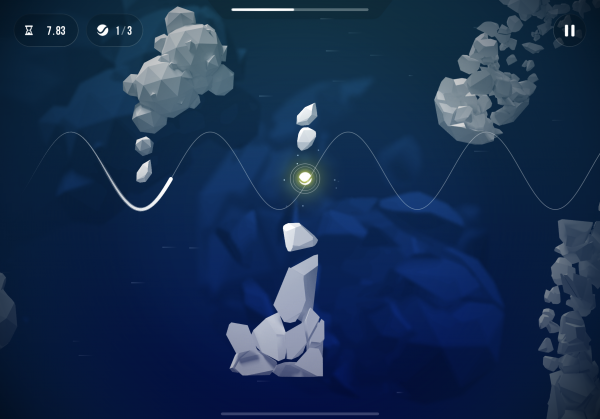Sine the Game review
Price: $2.99
Version: 1.0.1
App Reviewed on: iPad Pro
Graphics/Sound Rating:





User Interface Rating:





Gameplay Rating:





Replay Value Rating:





Overall Rating:





Sine is a deceptively difficult game. It tests your ability to recognize patterns while balancing speed and precision by making you steer an object along a sine wave path. There's not much more to it than that, but Sine presents its simple action in a slick package while serving up levels that present a healthy challenge.

Speedy swerving
In Sine, you control an object that moves up and down along a sine wave. You can't control the object directly, but you can shorten or lengthen the frequency of the wave path by sliding left and right on the screen. Your goal is to guide the object through levels full of rocks and other objects so that you don't crash into anything.
Simple survival is just where the game starts, though. Sine also scatters collectibles in its levels and has a time challenge for each one, and fully clearing a level involves collecting everything and finishing quickly. In this way, Sine somewhat feels like a racing game, though it's one where you're racing against the clock.
Retrain your brain
Sine constantly displays the trajectory of your object and how it shifts with your swipes. Although this sounds like it should make the game too easy, the speed at which your object moves makes it so you're constantly glancing back and forth to make sure your current path is clear and that future oscillations are unobstructed. In some ways, this actually makes the action more chaotic.
A big reason for this is the fact that changing your sine wave trajectory actually changes both your object's speed and the pace at which you move through a level. It makes intuitive sense that reducing the frequency of a wave path into gentle hills makes for a more efficient route through a level, but the fact that doing this also causes your object to accelerate more feels less natural and can make it hard to gauge timings. This is primarily what makes Sine tough to wrap your mind around.

Ups and downs
The demands of Sine are interesting, but I found that--as I spent more time with it--training myself to meet them wasn't particularly satisfying. Perhaps it's because of Sine's odd movement mechanics, or the fact that it only almost seems like a racing game, but something about its challenge feels too artificial.
That being said, gliding through levels perfectly on an initial run feels incredible, so perhaps it's my own personal lack of discipline and patience that makes Sine seem dull when I'm struggling on levels. In either case, there's something about what Sine asks for that I only want to deliver on my own terms, and when I can't do that I have a hard time appreciating it.
The bottom line
I'm not one to shy away from difficult games, but when demands get too exacting, the experience feels more like work than play. This, unfortunately, happens with Sine. I wouldn't necessarily say this makes it a bad game, but it makes it one that I lost interest in after the first two worlds or so due to its strange degree of challenge.



